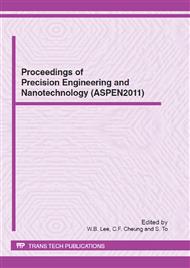p.154
p.160
p.166
p.170
p.176
p.181
p.186
p.192
p.198
5-Axis Control Dexterous Ultraprecision Micromilling of Ruled Surface with Side Cutting Edge
Abstract:
This study deals with 5-axis control tool path generation to create microshapes dexterously and efficiently, while maintaining quality. Concerning 5-axis control machining, the use of ball end mills is generally employed. However, this method needs a lot of time to obtain high quality surface. To solve this problem, a side cutting edge of the ball end mill is positively utilized with its parallel to the ruled surface. Therefore, a new CAM system is developed to detect the surface to be machined with the side cutting edge, and to generate collision-free tool paths between the tool and the work piece. The effectiveness of the developed CAM system is experimentally confirmed by creating a tiny Möbius ring.
Info:
Periodical:
Pages:
176-180
Citation:
Online since:
June 2012
Authors:
Price:
Сopyright:
© 2012 Trans Tech Publications Ltd. All Rights Reserved
Share:
Citation:


